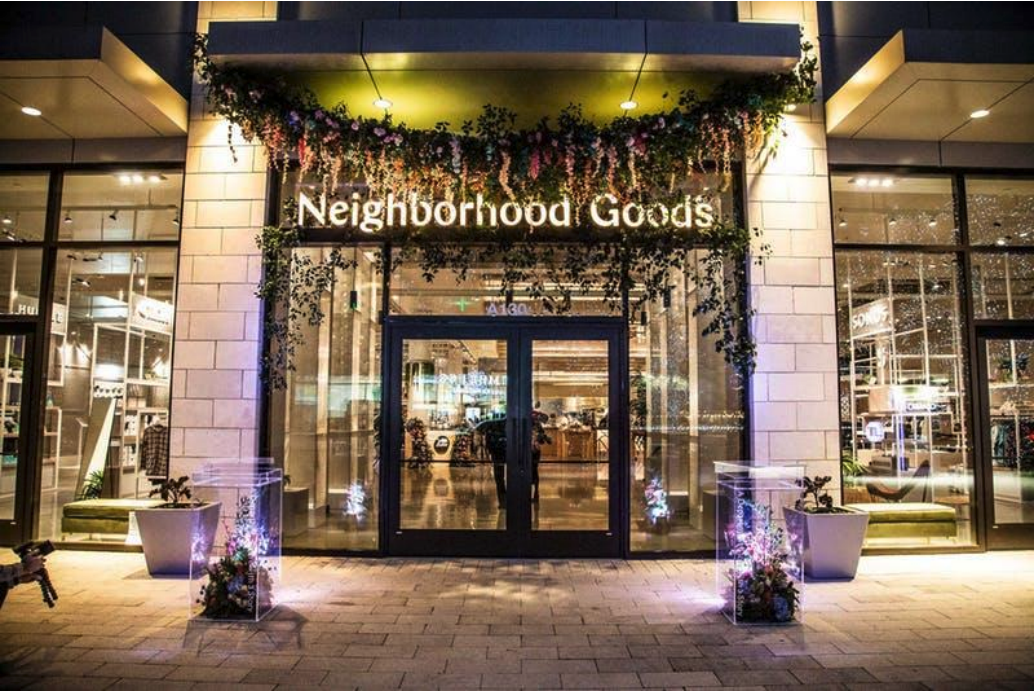
Nitheesh NH
We present key insights from our conversation with Matt Alexander, Founder and CEO of Neighborhood Goods, from an exclusive fireside chat presented by RevTech Ventures on August 5, 2020. The webinar was hosted by Deborah Weinswig, CEO and Founder of Coresight Research.
 Source: Company website[/caption]
3. Weathering the Pandemic: Booming Digital Sales
Neighborhood Goods originated primarily as a physical store, loosely following the structure of a traditional department store. Initially, digital sales channels were a second priority—so much so that some in the company questioned whether to pursue online sales at all. Today, Alexander is thankful that the company did launch online, and has emphasized how Neighborhood Goods’ e-commerce business has become “like a fourth store.”
Driven by an increase in online shopping amid Covid-19, the company’s online sales have outperformed its own projections by a factor of 20–30X, according to Alexander. In May 2020, Neighborhood Goods’ e-commerce business outperformed its in-store sales from May 2019—meaning that online sales during the pandemic were better even than the company’s physical store record during a typical pre-crisis period.
Alexander acknowledged the role that the Covid-19 pandemic has played in accelerating the growth of the company’s e-commerce business, but also credits several intentional developments for its success:
Source: Company website[/caption]
3. Weathering the Pandemic: Booming Digital Sales
Neighborhood Goods originated primarily as a physical store, loosely following the structure of a traditional department store. Initially, digital sales channels were a second priority—so much so that some in the company questioned whether to pursue online sales at all. Today, Alexander is thankful that the company did launch online, and has emphasized how Neighborhood Goods’ e-commerce business has become “like a fourth store.”
Driven by an increase in online shopping amid Covid-19, the company’s online sales have outperformed its own projections by a factor of 20–30X, according to Alexander. In May 2020, Neighborhood Goods’ e-commerce business outperformed its in-store sales from May 2019—meaning that online sales during the pandemic were better even than the company’s physical store record during a typical pre-crisis period.
Alexander acknowledged the role that the Covid-19 pandemic has played in accelerating the growth of the company’s e-commerce business, but also credits several intentional developments for its success:
Creative and Attentive In-Store Experiences, Interactive Technology and Online Sales Growth
1. People-Centric Stores: Prioritizing Customers, Employees and Experiences When Alexander looks for brands to add to the Neighborhood Goods portfolio, he generally has one criterion: They must be willing and able to bring something fun and interesting to the store. Alexander referenced his company’s work with Dollar Shave Club to evolve the brand’s presence in the store from a simple vending machine to displaying its products in a tiled area surrounded by waterfalls to mimic the atmosphere of a luxury bathroom. Alexander does not envision Neighborhood Goods as the store where consumers go to replace an old pair of jeans—it is the store that people seek out to for a unique experience exploring new brands. Although he acknowledge that branded experiences are important, Alexander said, “People don’t care about brands; they care about people.” Neighborhood Goods puts people—both employees and customers—at the center of its in-store experience. Alexander underlined the fact that store employees are in the same Slack (a business communication tool) group as corporate employees, enabling them to communicate qualitative insights they gain while working with customers, to contribute to the store’s success. According to Alexander, store employees are also paid at least $10 above minimum wage and are encouraged to work in a section of the store that sells products they are passionate about. Alexander cited the size of the company’s stores and the passion and knowledge of the sales associates as key components of Neighborhood Goods’ success. By limiting brand assortment and motivating sales associates, the company ensures that brands are represented correctly, and that staff are highly knowledgeable about every item in their area of the store. The company provides extensive training materials to staff, and sometimes sends personnel to meet with brand representatives before products enter the store to allow them to get a better understanding of what they will be selling. Furthermore, the company has expanded its private-label offerings following the success of its small initial line of T-shirts and sweatshirts. Each Neighborhood Goods location now offers tote bags with different graphics on them based on the location of the store, in addition to a wider array of hats and shirts adorned with smiley faces and simple designs. The company says it has had an influx of requests from brands to collaborate on private-label offerings. As some smaller brands continue to struggle with supply-chain issues, Alexander believes that continuing the success of Neighborhood Goods’ private-label offerings will be vital to the future of the pseudo-department store. 2. Complementing Face-to-Face Interactions with Interactive Technology Alexander cautioned that technology is not the solution to every retail problem. He argued that many retailers get too caught up in implementing new technologies at the expense of investing in the feel of the store and improving the person-to-person interactions that take place within it. At Neighborhood Goods, technology is mostly behind the scenes and not in customers’ faces. The company leverages technology to enable customers to dictate how they interact with the store. Technology-backed innovations employed by Neighborhood Goods include an online store traffic tool that allows customers to view levels of traffic in each store before deciding to visit in person. The retailer also offers BOPIS (buy online, pick up in store) and self-checkout through the Neighborhood Goods mobile app. All of these tech-based improvements are aimed at optimizing the customer experience and are completely optional. Neighborhood Goods’ goal is to enable consumers to reach it on any platform, but the retailer also respects the wishes of shoppers who would rather stick to the traditional brick-and-mortar experience. Furthermore, Neighborhood Goods utilizes data and analytics to enhance its in-store and omnichannel experiences. On the product side, the company has recently rolled out a platform to provide real-time sales reporting and data to its brands. [caption id="attachment_114450" align="aligncenter" width="700"] Source: Company website[/caption]
3. Weathering the Pandemic: Booming Digital Sales
Neighborhood Goods originated primarily as a physical store, loosely following the structure of a traditional department store. Initially, digital sales channels were a second priority—so much so that some in the company questioned whether to pursue online sales at all. Today, Alexander is thankful that the company did launch online, and has emphasized how Neighborhood Goods’ e-commerce business has become “like a fourth store.”
Driven by an increase in online shopping amid Covid-19, the company’s online sales have outperformed its own projections by a factor of 20–30X, according to Alexander. In May 2020, Neighborhood Goods’ e-commerce business outperformed its in-store sales from May 2019—meaning that online sales during the pandemic were better even than the company’s physical store record during a typical pre-crisis period.
Alexander acknowledged the role that the Covid-19 pandemic has played in accelerating the growth of the company’s e-commerce business, but also credits several intentional developments for its success:
Source: Company website[/caption]
3. Weathering the Pandemic: Booming Digital Sales
Neighborhood Goods originated primarily as a physical store, loosely following the structure of a traditional department store. Initially, digital sales channels were a second priority—so much so that some in the company questioned whether to pursue online sales at all. Today, Alexander is thankful that the company did launch online, and has emphasized how Neighborhood Goods’ e-commerce business has become “like a fourth store.”
Driven by an increase in online shopping amid Covid-19, the company’s online sales have outperformed its own projections by a factor of 20–30X, according to Alexander. In May 2020, Neighborhood Goods’ e-commerce business outperformed its in-store sales from May 2019—meaning that online sales during the pandemic were better even than the company’s physical store record during a typical pre-crisis period.
Alexander acknowledged the role that the Covid-19 pandemic has played in accelerating the growth of the company’s e-commerce business, but also credits several intentional developments for its success:
- Neighborhood Goods has partnered with delivery firm Postmates to provide same-day delivery on its products in the cities where it has physical stores.
- The retailer’s website enables customers to make in-person or digital appointments with store staff, giving online customers the same immersive and personalized customer experience that they expect in stores.
- Neighborhood Goods is partnering with brands to launch online before they go in store. Alexander said that many brands had initially been apprehensive about launching online with the company, fearing it would cannibalize their own online business, but the success of Neighborhood Goods’ online store has helped brands to re-evaluate these concerns and subsequently contributed to the success of the company’s e-commerce business.
Key Takeaways
- Although Neighborhood Goods has some of the characteristics of a traditional department store, its emphasis on creating immersive in-store experiences, training passionate store staff, and building and integrating its online platform position the company to continue experiencing sales growth.
- By engaging with customers on their own terms, the company reaches a diverse array of individuals across various selling platforms.
- The boom of the company’s online business sparked by the pandemic has encouraged more brands to launch on its digital platform and should benefit the company long after the crisis is over.